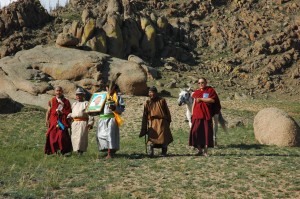
Call for Abstracts for Presentations on:
SACRED NATURAL SITES:
“An ancient Asian philosophy and practice with fundamental significance to protected areas”.
Deadline for submission: 15th June, 2013
Introduction:
IUCN WCPA Japan, the Biodiversity Network Japan and the Sacred Natural Sites Initiative in collaboration with the IUCN WCPA Specialist group on Cultural and Spiritual Values of Protected Areas invite abstracts focused on the modern significance of sacred natural sites and the practice and operation of protected areas with reference, where appropriate, to an Asian Philosophy of Protected Areas.
In addition to description and analysis of the culture and tradition of sacred natural sites and their position in protected areas, authors can also outline challenges faced in the efforts to maintain culture and tradition in the face of strong modernising forces.

Mongolia’s Bogd Khan protected Area is associated with the life of Ghengis Khan and has been a national protected sacred natural site since 1778. It is now part of the extensive Khan Khentii Mountain Protected Area. After many years of communist suppression, ceremonies have been revived led my local Buddhist lamas. The ceremonies honour the deities of the mountains and petition against drought and heavy snow. Here the group that performs the ritual at the most sacred part of the mountain, the top, returns led by monks. Third person from the left is Mr. J. Boldbaatar, Director, Khan Khentii Special protected Area and on his right the first modern day park ranger (see case study in the IUCN UNESCO Guidelines). Photo: Robert Wild.
Guiding Questions:
- To what extent do Sacred Natural Sites form the backbone of many protected areas in Asia, e.g. their cultural, spiritual and philosophical underpinnings?
- What is the modern relevance of Ancestral Sacred Natural Sites to Protected Areas and how can this be better recognised and the traditional guardians be engaged?
- How can we improve management effectiveness, governance and equity of Sacred Natural Sites within and outside government protected areas in Asia?
Sources of reference:
- The Best Practice Guideline No16: Sacred Natural Sites – Guidelines for Protected Area Managers,
- The WCC-2012-Rec-147 Sacred natural sites – support for custodian protocols and customary laws in the face of global threats and challenges.
Organisation:
Under Theme 3 on Culture, Tradition and Protected Areas this 2.5 Hour session will include 6 presentations and discussion with some 60 to a 100 participants.
Submission of abstracts:
Abstracts and author bios of 150 words each should be submited following the application form. It should be send to info@asia-parks.org with cc to info@sacrednaturalsites.org
Objectives:
- Bring together guardians, conservation practitioners, protected area specialists and others in the recognition, conservation and management of sacred natural sites,
- Understand their biocultural conservation relevance today as ancient commons and ancestral protected areas,
- Review recent conservation initiatives for their development into online case studies with special reference to the review and testing of the IUCN-UNESCO Guidelines,
Outcomes:
- Develop short online presentation of the case studies presented in this session following a simple format. Click here to see examples of online presentations and download the case study template.
- Identification of case study sites for implementing and testing of the IUCN UNESCO Guidelines, BPG16 on Sacred Natural Sites,
- Bring some of the case studies and lessons learned to the World Parks Congress in 2014.
Side event and field trip:
The organisers are currently exploring the opportunity of an additional side event for protected area managers, scientists and guardians as well as a Sacred Natural Sites related field trip.
Funding:
Limited financial support is available to assist 3 indigenous Guardians and/or Protected Area experts from Asian Developing countries with their travel costs kindly provided by Keidanren Nature Conservation Fund. We are especially interested in supporting Guardians that are managing their own Sacred Natural Sites in the context of a State Protected Area or an Indigenous and Community Conserved Area (ICCA). Experience with the IUCN UNESCO Guidelines on Sacred Natural Sites would be welcome. For support funding please contact info@sacrednaturalsites.org.







One Response
Dear Sir/Madam
It is my pleasure to inform you, I am Master in Biodiversity working on Animism significances of Himalayan sacred lakes for biodiversity conservation, restore sacred sites for freshwater and biodiversity conservation, research, training and public education (CEPA) in Nepal.
I have prepared Presentation abstract under the Theme of 3rd for Asian Park Congress already. I am seeking funding support. How I can apply for funding support. I will be very much happy and able to explore my aspiration to the Congress.
Thanks with regards
Kamal Rai
Indigenous Knowledge and Peoples Network
Himalayan Folklore and Biodiversity Study Programme
Wetland Biodiversity Conservation Society Nepal
Po Box 12476
Kathmandu
Nepal